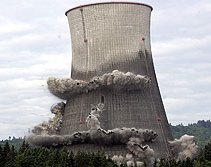Yet I sleep well every night knowing that we have the power and knowledge to make the necessary changes.
Future and History of Nuclear Energy:
- Nuclear power capacity worldwide is increasing steadily, with over 50 reactors under construction in 13 countries.
- Most reactors on order or planned are in the Asian region, though there are major plans for new units in Europe, the USA and Russia.
- Significant further capacity is being created by plant upgrading.
- Dangerous plant life extension programs are maintaining capacity, in USA particularly.
Today there are some 436 nuclear power reactors operating in 30 countries that provide about 15% of the world's electricity.
About 50 power reactors are currently being constructed in 13 countries.
The International Atomic Energy Agency in its 2009 report significantly increased its projection of world nuclear generating capacity. It now anticipates at least 73 GWe in net new capacity by 2020, and then 511 to 807 GWe in place in 2030 - very much more than projected previously, and 37% to 116% more than the 327.5 GWe actually operating in 2009. OECD estimates range up to 680 GWe in 2030. The change is based on specific plans and actions in a number of countries, including China, India, Russia, Finland and France, coupled with the changed outlook due to the Kyoto Protocol. The IAEA projections would give nuclear power a 13.5 to 14.6% share in electricity production in 2020, and 12.6 to 15.9 % in 2030. (WNA)
The fastest growth is in Asia.
It is noteworthy that in the 1980s, 218 power reactors started up, an average of one every 17 days. These included 47 in USA, 42 in France and 18 in Japan. The average power was 923.5 MWe. So it is not hard to imagine a similar number being commissioned in a decade after about 2015. But with China and India getting up to speed with nuclear energy and a world energy demand double the 1980 level in 2015, a realistic estimate of what is possible might be the equivalent of one 1000 MWe unit worldwide every 5 days. (WNA)
See also Nuclear Renaissance paper for the factors driving the increase in nuclear power capacity, and also WNA's Nuclear Century Outlook.
Most reactors currently planned, with fast-growing economies and rapidly-rising electricity demand. HTML clipboard
 The Trojan nuclear power plant, located 40 miles north of Portland, Oregon, was closed in 1993 due to safety and financial concerns. On May 21st, 2006, 2,800 pounds of explosives were used to implode it's 499 foot cooling tower. The remainder of the plant won't be cleaned up until 2024 as there are spent radioactive fuel rods and other debris that need to be removed... |
In all, over 130 power reactors with a total net capacity of almost 150,000 MWe are planned and over 250 more are proposed. Rising gas prices and greenhouse constraints on coal have combined to put nuclear power back on the agenda for projected new capacity in both Europe and North America. (WNA)
In the USA there are proposals for over twenty new reactors and the first 17 combined construction and operating licenses for these have been applied for. All are for late third-generation plants, and a further proposal is for two ABWR units. it is expected that 4 to 8 new reactors will be on line by 2020.
In China, now with eleven operating reactors on the mainland, the country is well into the next phase of its nuclear power program. Some 22 reactors are either under construction or likely to be so by the end of 2009. These include the world's first Westinghouse AP1000 units and a demonstration high-temperature gas-cooled reactor plant. Another 27 units are planned, with construction due to start within three years. But most capacity under construction will be the largely indigenous CPR-1000. China aims at least to quadruple its nuclear capacity from that operating and under construction by 2020.
India has six reactors under construction and expected to be completed by 2010. This includes two large Russian reactors and a large prototype fast breeder reactor as part of its strategy to develop a fuel cycle which can utilise thorium. Further units are planned. Ten further units are planned, and plans for more - including western and Russian designs - are taking shape following the lifting of trade restrictions.
Plant Life Extension and Retirements
Most nuclear power plants originally had a nominal design lifetime of 25 to 40 years, but engineering assessments of many plants have established that many can operate longer. In the USA some 60 reactors have been granted licence renewals which extend their operating lives from the original 40 out to 60 years, and operators of most others are expected to apply for similar extensions. Such licence extensions at about the 30-year mark justify significant capital expenditure for replacement of worn equipment and outdated control systems.
The 2009 WNA Market Report reference case has 143 reactors closing by 2030, using very conservative assumptions about license renewal.